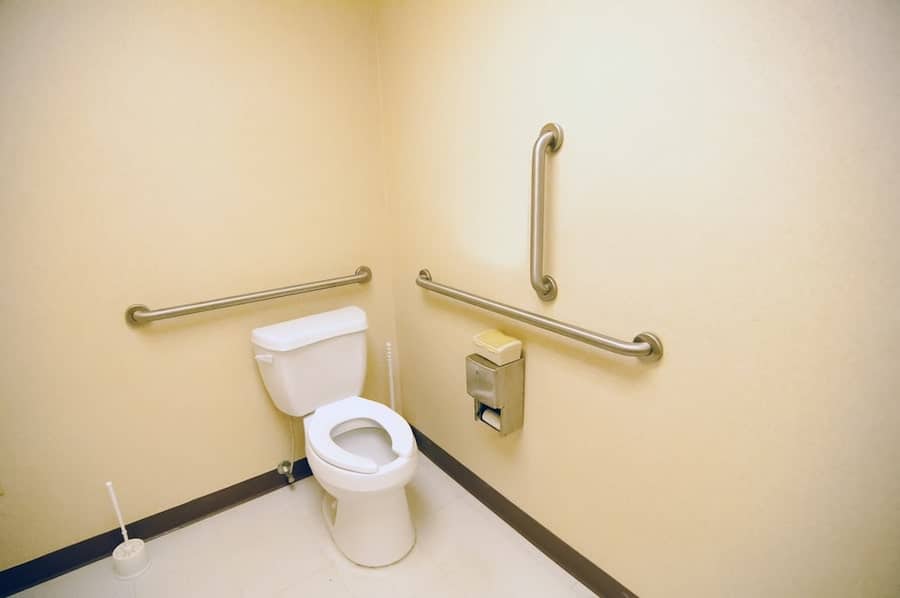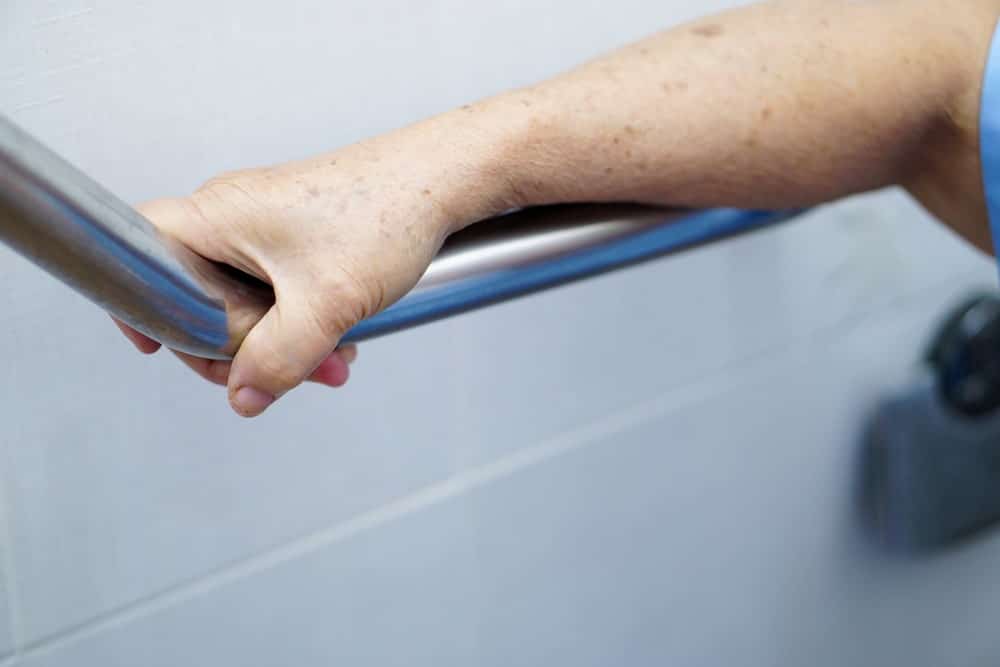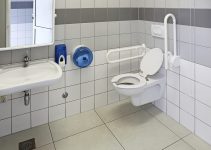Grab bars are innovative and practical modifications for senior citizens and people with mobility issues.

Bathrooms are one of the high-risk places where falling is most frequent. A fall on slippery and hard floors of the bathroom can cause various injuries, from superficial bruises to severe head injuries, and in extreme cases, can prove fatal.
As you get older, the possibility of injury from falls is perturbing, so how can a grab bar help? Grab bars aid standing or sitting by supporting the weight of the body and providing a firm holding point to aid stability.
Don’t know how high should grab bars be installed? Generally speaking, the installation height range is 33 to 36 inches from the floor. However, you will find more details in this brief guide.
Americans With Disabilities Act (ADA) Grab Bar Installation Guide
When installing a grab bar in your home, it is crucial to determine the most appropriate height for the intended user.
This is not as easy as it sounds. If it’s a rail to get out of a bath, for example, determine the height, not only the most effortless reach from a sitting position but also the height that will most help the user attain an upright position.
The Americans with Disabilities Act (ADA) offers standards and excellent guidelines for installing grab bars. These standards ensure their universal accessibility.
Commercial facilities, public accommodations, and government facilities use these guidelines, but they can apply to domestic properties too. These standards vary depending on the type and location of grab bars.
Installing the grab bars at the wrong height will defeat the object of the installation, which is to offer help and stability to those with mobility or balance problems.
Types of Grab Bars
There are three types of grab bars, vertical, diagonal, and horizontal.
ADA guidelines specify that horizontal grab bars be installed on the side and rear wall of the toilet. Vertical grab bars are useful for people who have arthritis, as they offer a more comfortable grip.
Most domestic grab bars are installed inside the house. For outdoor installation, diagonal grab bars are often used. The diagonal grab bars can accommodate different installation angles depending on the slope of the stairs or path.
Vertical grab bars are installed vertically to accommodate the height of as many users as possible. They should be installed in places where users need to get from a sitting to a standing position.
It’s best to use a textured grab bar for added grip and prevent the user’s hands from slipping.
Apart from the direction they go, there are different styles of grab bars, including:
- Straight grab bars
- Entrance grab bars
- Wave-style grab bars
- Grab bar towel rack
- Grab bar toilet paper holder
Grab Bar Height Guide
Below is a detailed guide on the ideal grab bar installation height. The height depends on the grab bar’s location.
For horizontal grab bars being installed in a shower or toilet, the installation height range is 33 to 36 inches from the floor. If you have a transfer shower, the vertical grab bar’s bottom must be 3 to 6 inches above the installed horizontal grab bar.
The ICC/ANSI A117.1 Accessible and Usable Buildings and Facilities states the required positioning for vertical grab bars. The installation guides are:
- A vertical grab bar 18 inches minimum in length mounted along the side wall.
- Centerline of the bar, to be located 39 inches minimum and 41 inches maximum from the rear wall.
- Bottom of the bar, to be located 39 inches minimum and 41 inches maximum above the floor.
If using a vertical grab bar as a diagonal safety rail, pick a 24-inch grab bar. The recommended installation angle is 45 degrees. The rail should be sloped upwards towards the showerhead. The rail’s lowest point ought to be 9 inches from the tub’s rim.
Angled or vertical grab bars are the best if you are looking for universal grab bars. They can offer stability, comfort, and safety in a wide range of situations.
Entrance Grab Bar Height
Entrance grab bars are vertically oriented grab bars (12, 16, or 18 inches long) offer support when going in or out of a bathroom or wet room. They’re installed at the entry point of a bathroom. The length of the entrance grab bar can be longer if there are multiple users of differing heights.
Entrance grab bars have standard accessible height guidelines. The vertical entrance grab bar is usually 16 to 18 inches long and installed on the wall opposite the faucet for a bathroom or wet room. Install the vertical entrance grab bars for a shower stall near the shower door jamb.
You can install entrance grab bars to help users get in or out of the shower. The grab bars can offer support at the lower point when standing up or getting seated. The installation height range remains the same. If the intended user has a shower chair and needs support at a lower point when standing or getting seated, it’s best to use a 24-inch grab bar.
It’s easy to lose footing when entering the bathroom, shower, or wet room. Proper installation of grab bars will increase safety a great deal.
Toilet Grab Bar Height

People who have a problem sitting and getting up from the toilet seat depend on toilet grab bars.
You should install toilet grab bars on each side of the toilet seat. This strategic installation will offer the most support and stability.
Horizontal toilet grab bars have a length range of 6 to 32 inches and have a standard installation height range of 33 to 36 inches from the toilet floor to the grab bar’s upper section. This installation height guarantees the most convenient accessibility for the majority of users.
Back Wall Grab Bar Height
Grab bars installed on the back wall of the bathroom, shower or toilet offer extra support.
Back wall grabs have a length range of 24 to 36 inches, depending on the installation location. The recommended installation height range of back wall grabs is 33 to 36 inches. Measure from the floor.
This standard height guideline is the best and flexible for all users. When installing a back wall grab bar, which is less than 32 inches in length, install it on the bathroom’s plumbing system wall.
Important Consideration Before Installation
Understanding their need will help pick the best grab bar installation height.
It is very important to monitor the movement of the user especially their basic transfer movements before installing the grab bars.
Ask how they feel when finishing these tasks is also helpful. If they can do them independently but feel difficult, it is time for installation already.
You should note down which type and how many you need and then purchase grab bars with high quality. If you intend to use it for a long time, bars made with stainless steel could be a better choice. Weight capacity is something you need to pay attention to when making a purchase.
We also suggest you consult with experts such as therapists or doctors. They will figure out an appropriate home improvement plan and tell you where are the best places to put these bars.
Conclusion
Homes, commercial facilities, public buildings, and government facilities all need grab bars to facilitate the infirm when necessary.
Proper installation of grab bars means fixing the grab bars at the perfect height to guarantee the most support to the intended user. Follow the ADA guideline and consider the need of the user, you will find the best place to install them easily.



